Kit Palmer | October 4, 2016
2017 Honda CBR1000RR SP First Look: Honda announced its all-new 25th anniversary CBR1000—the 2017 CBR1000RR SP and SP2. Right off the bat, Honda claims the new CBR weighs an amazing 33 pounds less and has 10 more horsepower than the previous model, which had not seen major updates in years. The more competition-focused, limited-production CBR1000RR SP2 comes with larger valves and lighter forged-aluminum Marchesini wheels.
MSRP has not yet been announced. The SP will be available in March 2017 and the SP2 in May 2017.
2017 Honda CBR1000RR SP First Look
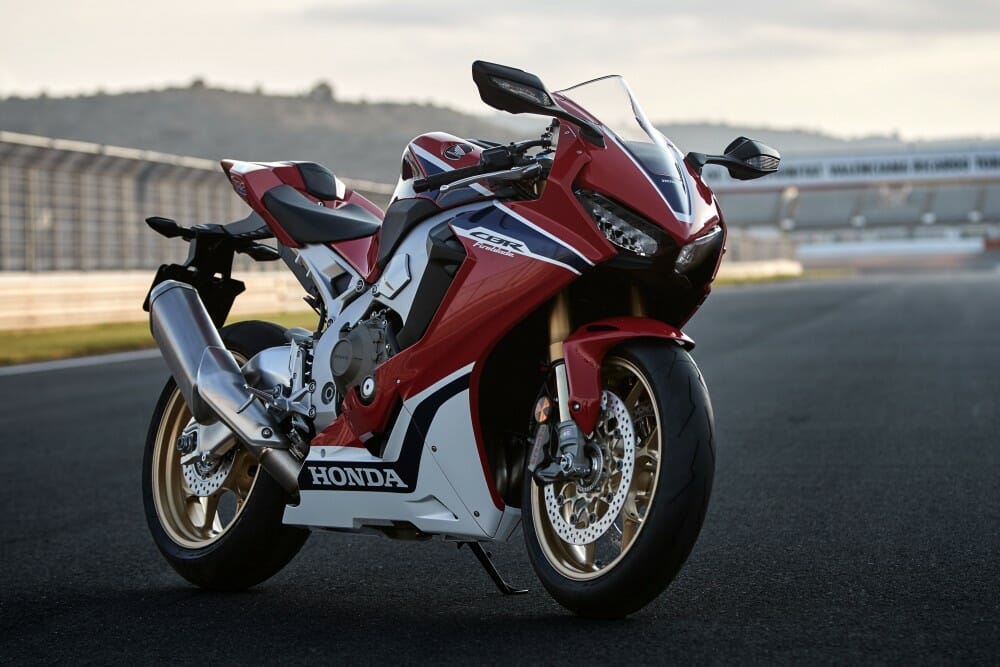 Honda’s all-new CBR1000 is here! The 2017 CBR1000RR SP and SP2 have it all, including full electronics.
Honda’s all-new CBR1000 is here! The 2017 CBR1000RR SP and SP2 have it all, including full electronics.
Here’s what Honda has to say about its new baby:
American Honda announced today that the legendary CBR1000RR SP has undergone a major overhaul for the 2017 model year, with a 33 lb. weight reduction and 10 horsepower increase resulting in a 14% improvement in power-to-weight ratio.
First introduced overseas in 1992 (and in the U.S. shortly thereafter), Honda’s largest CBR has continuously reset expectations of what an open-class sport bike should be, with a holistic “Total Control” design approach that focuses on cornering, acceleration and braking. That practice is taken to the next level with the 25th anniversary CBR1000RR SP, which is also fully loaded with a cutting-edge electronics package. The result is a machine that is underpinned by the “Next Stage Total Control” concept, with nimble handling and amazing acceleration.
“Since their debut, CBR liter bikes have been designed to perform in the real world, the way real customers use them,” said Lee Edmunds, Manager of Motorcycle Marketing Communications at American Honda. “We’re pleased to unveil the 2017 CBR1000RR SP, which follows in that same tradition by providing a superbly balanced package with our best power-to-weight ratio ever. It works incredibly well on track and, even more importantly, is both exhilarating and uniquely rewarding to ride out on the open road.”
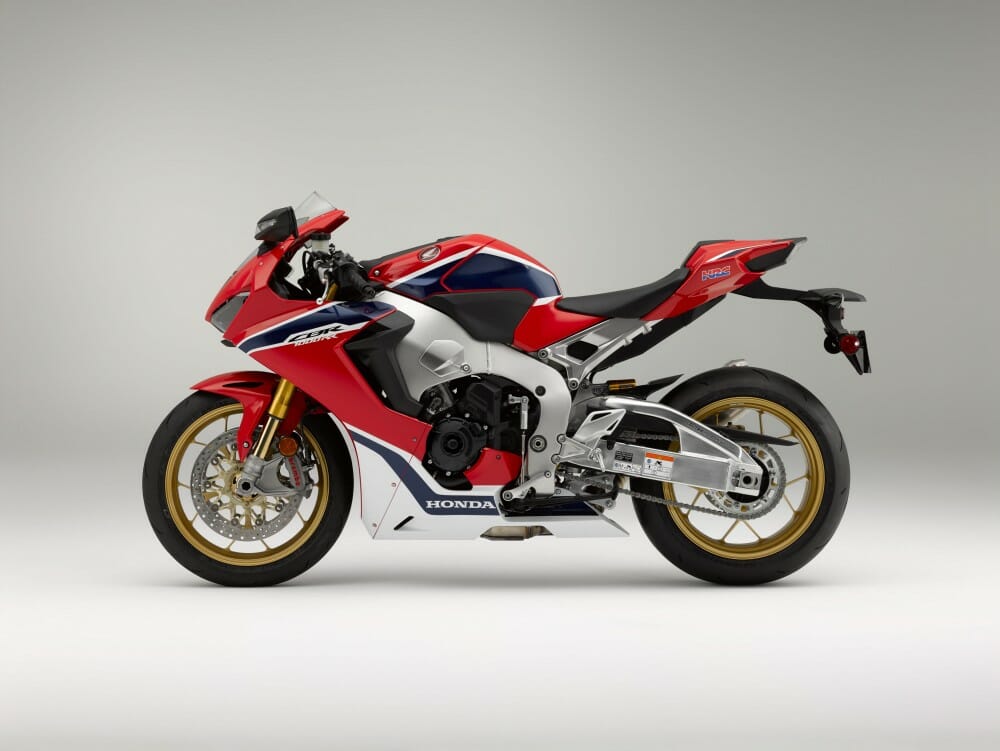 Electronics for the CBR1000RR SP (shown) and SP2 come straight from the RC213V-S.
Electronics for the CBR1000RR SP (shown) and SP2 come straight from the RC213V-S.
The CBR1000RR SP has received a vast array of improvements, including some that come straight from the RC213V-S. Electronics play a big role, including semi-active Öhlins Electronic Control suspension (S-EC), plus a number of rider aids built around the five-axis Inertial Measurement Unit (IMU). Power and torque have been increased through a higher compression ratio and revised cam timing, while ample use of magnesium (engine covers) and titanium (muffler and—for the first time on a mass- production road bike—fuel tank) have reduced weight and improved mass centralization. The twin-spar aluminum frame’s rigidity balance has been finely adjusted, and the swingarm is stiffer. Brembo monobloc four-piston front brake calipers use high-performance track-ready brake pads, while a narrower radiator and new bodywork achieve a slimmer profile.
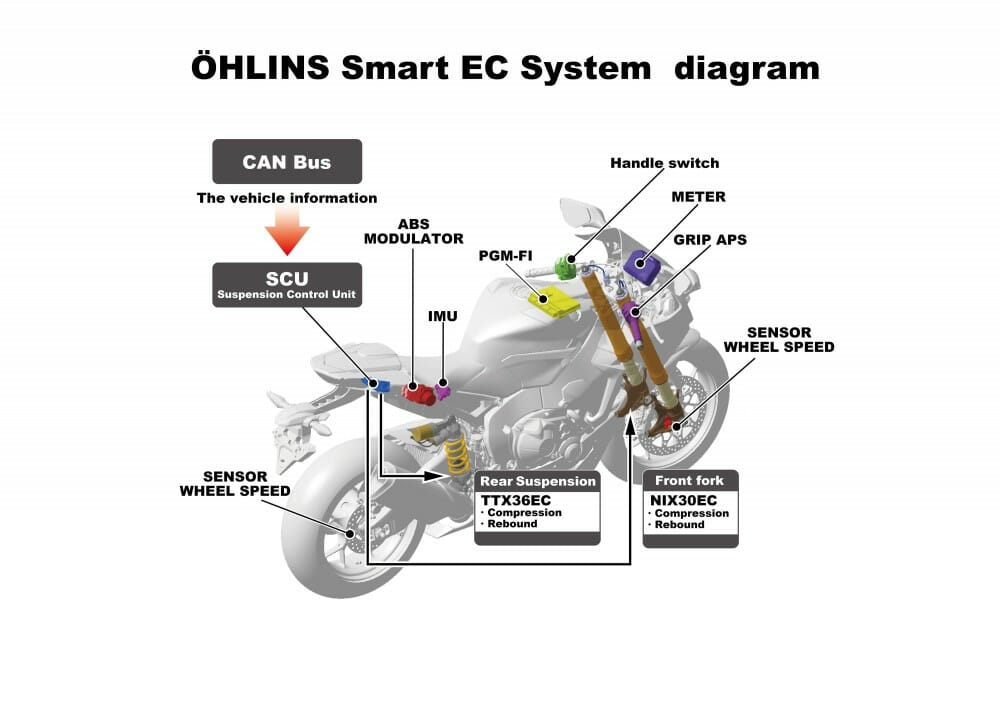
FEATURES
Engine/Drivetrain
Valve lift and timing have been optimized for higher engine speeds, with the maximum raised from 12,250 to 13,000 rpm.
Thickness of different areas of pistons optimized, retaining same weight while increasing compression ratio from 12.3:1 to 13.0:1.
Piston rings have Diamond Like Carbon (DLC) coating that improves sealing property.
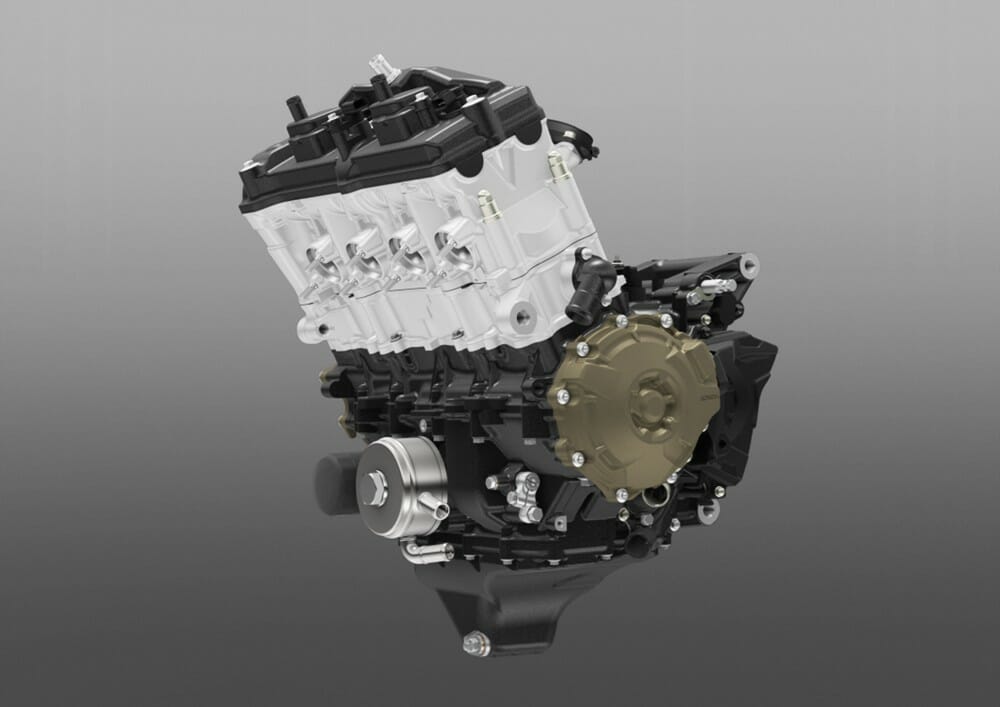 Honda claims 10 more horsepower from the new engine and 750 (RPM) more revs on top.
Honda claims 10 more horsepower from the new engine and 750 (RPM) more revs on top.
A new air-intake duct and air box with reduce air resistance, with a throttle-body bore that is up 2mm to 48mm. Fuel-discharge pressure is up 14%, promoting fuel atomization and raising combustion efficiency, while throttle response is improved by intake funnels with a slash-cut design.
Magnesium construction of the oil pan and ignition cover contribute to a 4.4 lb. reduction in engine weight.
Assist force in the slipper clutch has been increased, resulting in a 17% lower clutch-spring load. Die-cast aluminum assist cams (transmitting & receiving) reduce weight, while optimized clearance between the cams improve clutch-lever feel.
The new, titanium muffler is 6.17 lbs. lighter, improving concentration of mass. Its double pipe structure enables more effective utilization of the expansion chamber, while the variable exhaust valve achieves an improved sound and good power delivery across the rpm range.
Derived from the RC213V-S, the nine-level Honda Selectable Torque Control (HSTC) measures front and rear wheel speeds and body roll angle, and also uses attitude-detection technology developed for ASIMO.
Wheelie behavior is electronically mitigated during acceleration; based on wheel speeds, the ECU decreases the throttle-valve opening to reduce torque.
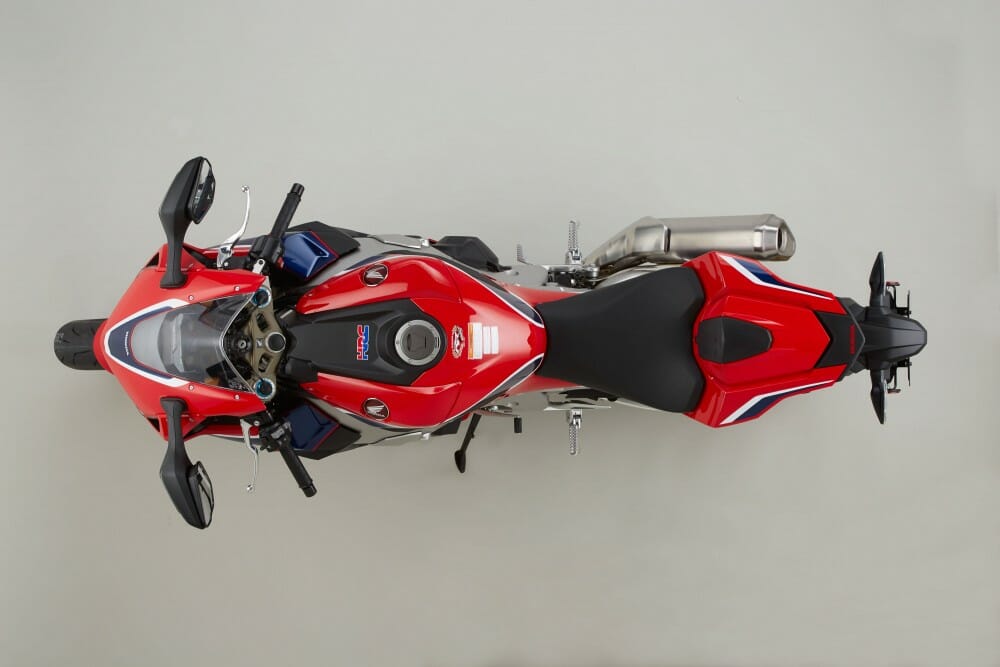 The new CBR1000RR SP/SP2 has a narrower profile.
The new CBR1000RR SP/SP2 has a narrower profile.
The slip rate of the rear wheel is restrained during cornering and acceleration; torque is controlled based on vehicle roll angle, such as when turning, contributing to a sense of security during the riding experience.
The rider can choose how strongly the engine brake is applied when the throttle is closed during deceleration; three levels of adjustability are available, depending on rider preference.
A quick shifter allows shifting up or down without use of the throttle or clutch; the driving load on gears is reduced during shifting, simplifying the rider’s shifting process on the track, on winding roads or in traffic. For both upshifting and downshifting, feel can be adjusted between three levels.
Adapted from the RC213V-S, the throttle-by-wire system (a first on a straight-four Honda) features a built-in Accelerator Position Sensor and improves response and rideability.
A first on a Honda, the full-color thin-film-transistor liquid crystal meter features Street, Circuit and Mechanic displays and is designed to be less intrusive for the rider.
On the fly, the rider can choose from three riding modes, each of which offers a preselected combination of power level, HSTC, engine braking and suspension. Two additional “user” settings allow custom combinations of settings.
The lithium-ion battery is one-half the weight of the previous, lead-acid battery. Service life is improved, and the central mounting location helps improve mass centralization.
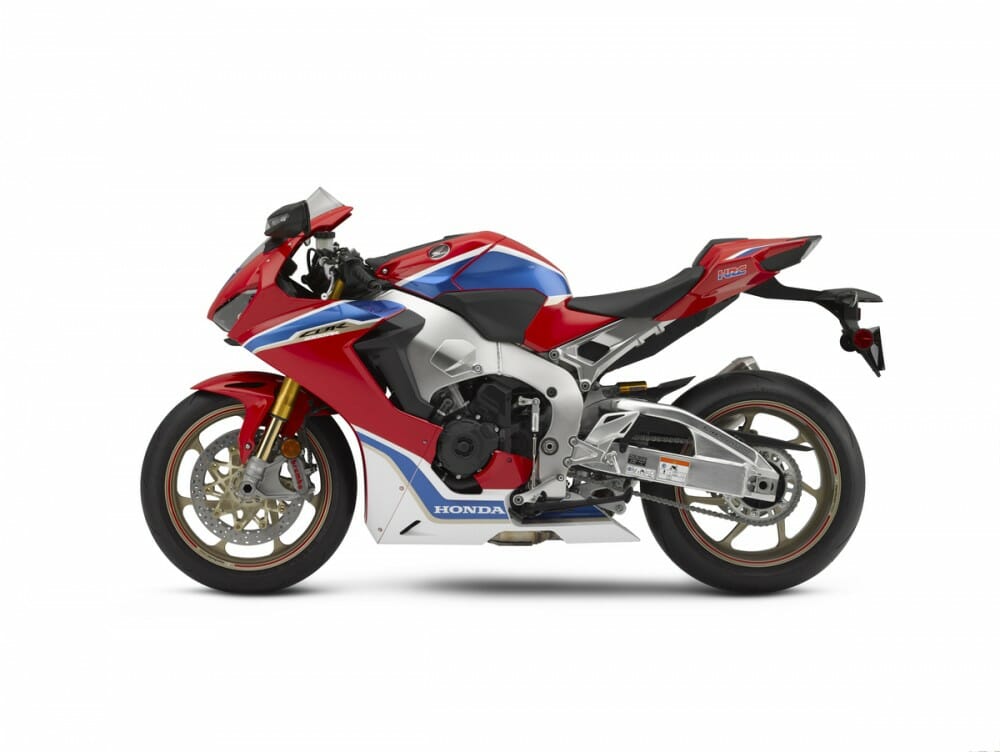 This is the limited-production SP2 with lighter wheels and valves.
This is the limited-production SP2 with lighter wheels and valves.
Chassis/Suspension
Portions of frame walls have been thinned down to reduce weight by 300 grams while maintaining appropriate flexibility.
Redesigned die-cast aluminum subframe is 600 grams lighter.
Swingarm section thicknesses have been adjusted resulting in weight reduction of 300 grams lighter and an increase in torsional rigidity.
Wheels have five Y-spokes instead of six for improved aerodynamic stability, while thickness has been reduced to cut weight by approximately 100 grams.
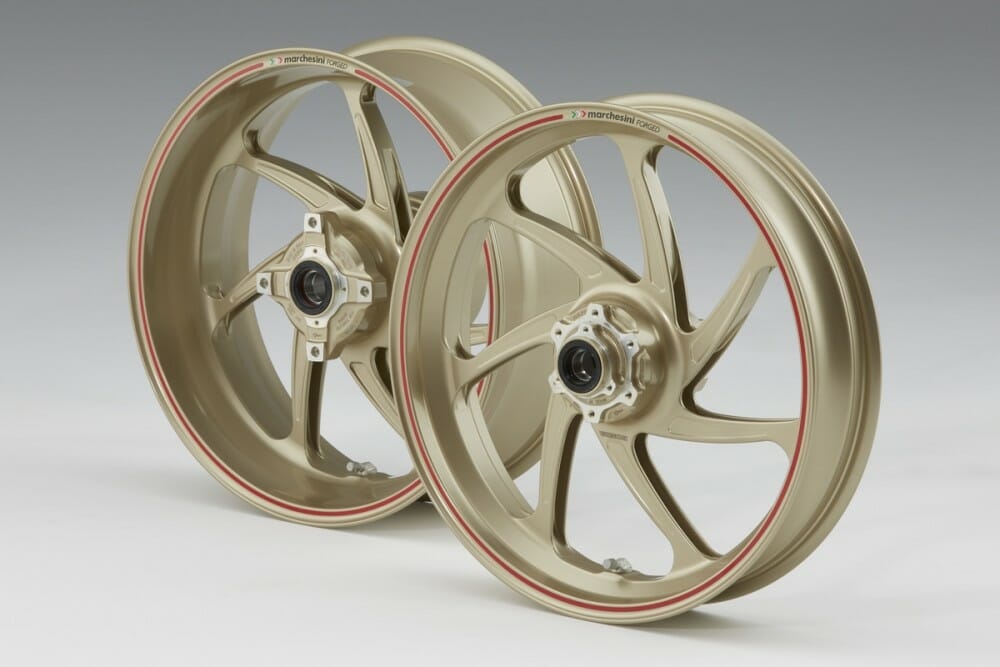 The SP2 wheels are ready for the track.
The SP2 wheels are ready for the track.
Radiator has a new high-density core that achieves same level of heat dissipation while reducing width by 30mm and weight by approximately 100 grams overall.
Minimalist, aggressive, aerodynamic design reduces widths at front of fairings; top fairing is 24mm narrow and middle fairing is 18mm narrower.
World’s first titanium fuel tank for a mass-production road bike is manufactured using ultra-deep drawing process; weight is reduced by 2.87 lbs., improved concentration of mass, and knee-grip area is 30mm narrower.
A first for a Honda production motorcycle, the CBR1000RR SP has semi-active Öhlins Electronic Control (EC) suspension, with 43mm NIX 30 EC fork and a TTX 36 EC shock. Settings are optimized electronically to suit the conditions.
The anti-lock braking system (ABS) features rear-lift control (RLC), for smooth, effective braking on corner entry; braking force is controlled according to lean angle, and hard trail braking is allowed.
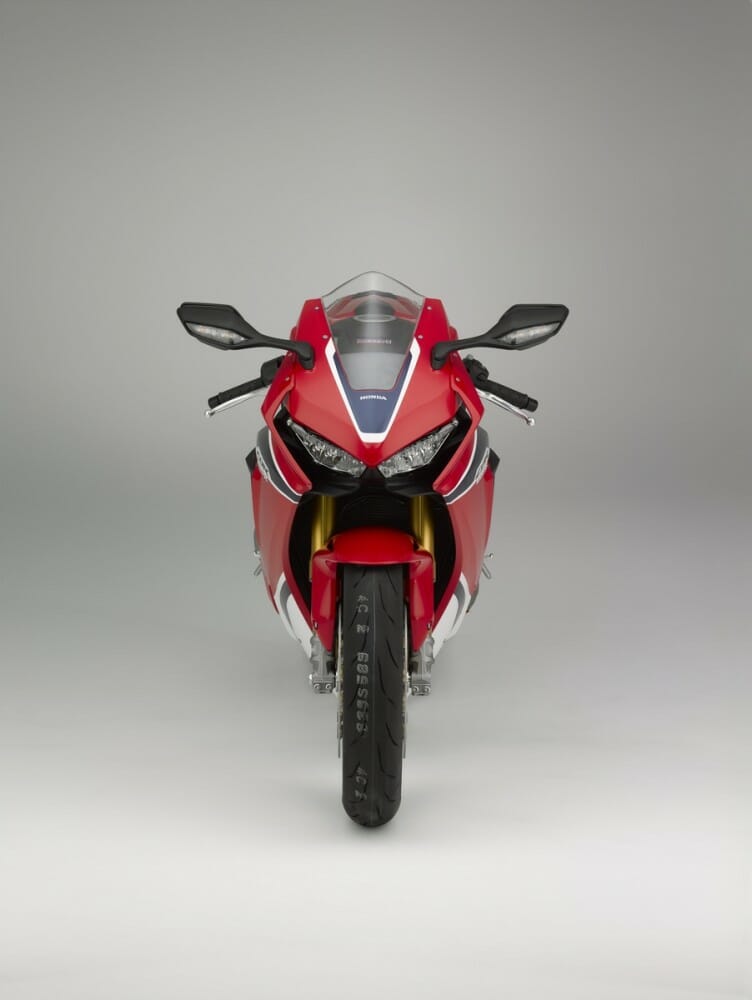 The CBR now has throttle-by-wire technology and plenty of rider aids.
The CBR now has throttle-by-wire technology and plenty of rider aids.
Meets current CARB and EPA standards.
Models sold in California meet current CARB standards and may differ slightly due to emissions equipment.
pipe.
Click HERE for more Honda-related news
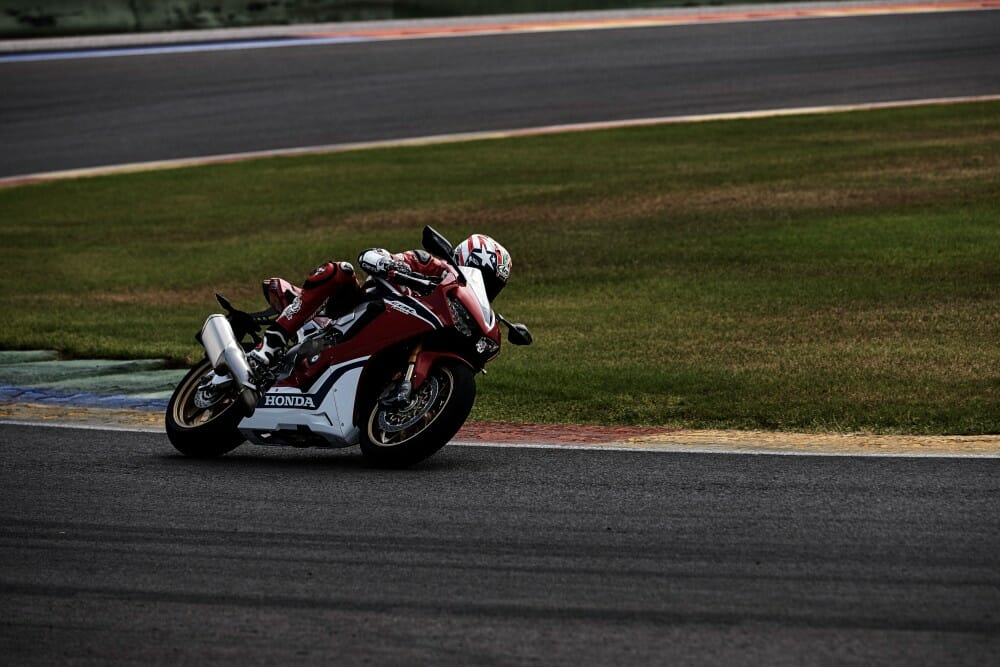 Too bad we have to weight until March to ride one. The SP2 is schedule for a May release.
Too bad we have to weight until March to ride one. The SP2 is schedule for a May release.